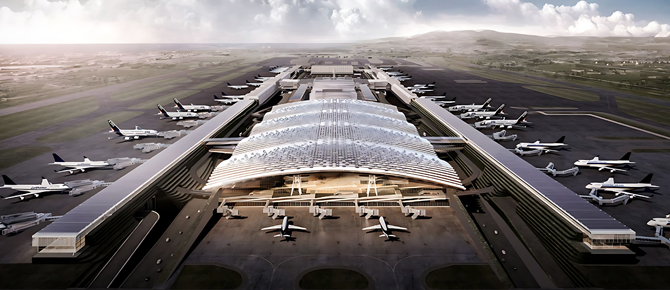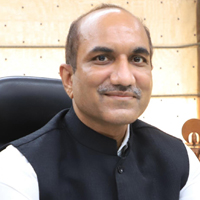
Airport Infrastructure – Aiming for SKY HIGH Growth!
Indian airport industry has witnessed a robust growth in the past few years with the number of airports witnessing an uptick from 74 in 2014 to 148 in 2023, which the government aims to further increase to 220 by 2024-25. The growth can be attributed to the government’s efforts to improve regional connectivity through UDAN-RCS, greenfield airport development and infrastructure expansions at existing airports. It’s the critical collaboration of stakeholders at play that has facilitated such an impressive growth of the aviation industry in the country in the last few years, writes PRERNA SHARMA.
The ever-increasing thrust on air travel as a preferred mode has only accentuated the need for greater connectivity. This growth has been facilitated by new age equipment, state-of-the-art technology, and the government’s fast-paced approval mechanism to make seamless air connectivity a REALITY by developing impressive infrastructural landmarks.
The growing potential of Indian aviation, driven by an expanding middle-class, rise in income fueled by a robust economy, has given rise to the concept of twin-airport model catering to such centers of demand. This started with the launch of Mopa airport in Goa in January 2023, with the existing airport at Dabolim still running at full steam. This year, the National Capital Region and Mumbai are also set to see the launch of Noida international airport and Navi Mumbai airport to cater to the rising demand.
“The industry is expected to gain from an increase in aircraft orders, as airlines are extensively allocating resources to acquire new fleets in response to rapidly growing demand. The construction work at Noida International Airport is progressing in full swing. We have reached the final floor level of the passenger terminal building. The air traffic control (ATC) tower, standing at its full height of 38 m, is on track to be finished and ready for handover to the Airports Authority of India by the first quarter of 2024. Additionally, the 3,900-metre runway is coming to life,” Christoph Schnellmann, CEO, Noida International Airport, stated to a news daily. The airport has recently onboarded IndiGo as its inaugural carrier, TajSATS for catering facility, and is expected to finalize food and beverage and lounge concessions over the next few weeks.
This is not all… the growing number of airports is also in sync with sustainability goals with the Airports Authority of India (AAI) preparing a roadmap to achieve 100% renewable energy usage for all operational airports by 2024, and net zero emissions by 2030. Moreover, the aviation sector is investing in fuel-efficient aircraft and sustainable aviation fuel. Some domestic airlines have already conducted demonstration flights using biofuel blended with aviation turbine fuel.
New-age airports are characterized by their adoption of technology and digital solutions, aimed at enhancing the passenger experience and providing a ‘Plug and Play’ environment for airlines. Several airports are using data analytics for optimized scheduling and route planning, and predictive maintenance algorithms to ensure the reliability of cargo aircraft. E-boarding, self-check-in kiosks, 3D baggage scanners and video surveillance systems are now becoming common features at airports. The DigiYatra App has been launched at 13 airports.
A capex of over Rs 980 billion has been planned for the airport sector during the period 2019-20 to 2024-25, with AAI spending approximately Rs 250 billion. The remaining expenditure will be incurred by airport developers under the public-private partnership model. The sector also offers opportunities in terms of airport privatization, the provision of maintenance, repair and overhaul services, and cargo infrastructure development.
Creating Infra Marvels…
Ayodhya’s temple town is gearing up for enhanced air connectivity with the much-talked about inauguration of its new airport just a few days back. Speaking about the newly built Maharishi Valmiki I

nternational Aiport in Ayodhya, Sanjeev Kumar, Chairman, Airport Authority of India (AAI), stated, “AAI has completed the construction of the Ayodhya airport in a record time of 20 months. Air connectivity is important for Ayodhya. With more passenger flow, the connectivity will also improve in Ayodhya. We at Airport Authority are extremely excited about this expansion.” Inspired by the upcoming Shri Ram Mandir of Ayodhya, the terminal building’s architecture reflects the historical and cultural significance of the region.
The airport features a runway with a length of 2200 meters, designed to accommodate the operation of A-321 type aircraft. Additionally, two link taxiways and an apron capable of parking eight A321 type aircraft, along with a designated Ground Support Equipment (GSE) area, have been constructed. Looking ahead to Phase 2 of development, plans include the construction of a new terminal building spanning 50,000 sqm. This expanded facility is expected to cater to 4,000 passengers during peak hours and serve a total of 60 lakh passengers annually. The expansion also encompasses the addition of a parallel taxi track and an apron with 18 additional aircraft parking stands.
The airport, developed at a cost of Rs.350 crore, includes the construction of various essential facilities such as the Terminal Building, ATC Tower, Fire Station, car parking, and allied city-side infrastructure. The terminal building, spanning 6500 sqm., is designed to accommodate 600 passengers during peak hours and serve 10 lakh passengers annually. Passenger amenities include nine check-in counters, three conveyor belts, and five X-BIS machines.
The building also incorporates various sustainability features, including an Insulated Roofing System, Canopies for energy savings, LED Lighting, Low Heat Gain Double Glazing Unit, Rainwater Harvesting, landscaping with fountains, HVAC, Water treatment plant, Sewage treatment plant, and the use of recycled water for landscaping.
In yet another significant development, Sanjeev Kumar has announced that Surat airport’s overall capacity will see a threefold increase with the inauguration of its new terminal building. The Union Cabinet, led by Prime Minister Narendra Modi, recently approved the proposal to declare Surat Airport as an international airport. This move is expected not only to make Surat a gateway for international travelers but also to streamline export-import operations for the thriving diamond and textile industries. The Surat Airport expansion, undertaken at a cost of Rs.353 crore, aims to meet the growing demands of passenger traffic and cargo operations. Currently connected to 14 domestic cities and internationally via Sharjah, the airport handles over 252 passenger flight movements per week. The new terminal, equipped to handle 1,200 domestic passengers and 600 international passengers during peak hours, is designed to reflect the local culture and heritage of Surat. Features include sustainability measures such as a solar power plant, rainwater harvesting, and the use of recycled water for landscaping.
Upgrading the Existing infrastructure
Ministry of Civil Aviation (MoCA) has taken initiatives for working towards Carbon neutrality and achieving net zero carbon emission at airports in the country by way of standardizing Carbon Accounting and Reporting framework of Indian Airports. For this purpose, airport operators with scheduled operations have been advised to map the carbon emission at their respective airports and to work towards carbon neutrality & net zero emission in a phased manner. MoCA has also advised developers of the upcoming Greenfield Airports and the respective State Governments to work towards achieving Carbon Neutrality & Net Zero which inter-alia includes use of green energy.
With the conscious efforts of the government, airports such as Delhi, Mumbai, Hyderabad and Bengaluru have achieved Level 4+ and higher Airports International Council (ACI) Accreditation and have become Carbon neutral. Additionally, 66 Indian Airports are operating on 100% Green Energy.
Chhatrapati Shivaji Maharaj International Airport (CSMIA) wraps up 2023 with a series of remarkable achievements, innovative technological upgrades, and a steadfast commitment to sustainability. From cutting-edge technology to world-class services, CSMIA has once again proved its mettle, solidifying its position as a leader in the aviation industry. In its unwavering commitment to excellence, CSMIA successfully concluded its major re-carpeting project for Runway 14/32, enhancing operational efficiency overall. Also introduced -‘Taxiway Z’ – CSMIA’s effort in reducing entry and exit times for aircraft and substantially lowering carbon emissions. The launch of Taxiway Z positioned CSMIA as the first in the Asian region to offer a flexible-use apron.
CSMIA also commissioned a specialized Disabled Aircraft Recovery Kit (DARK), making it the first airport in Asia to possess this facility with High-Pressure lifting bags. This has marked a significant step towards improving passenger safety and operational resilience. In contrast to typical low-pressure equivalents, the DARK facility at CSMIA ensures superior longevity, requires little staff, and provides a more effective recovery procedure. This makes it the first airport in Asia to use these lifting bags. An important issue in aviation is “runway excursion,” or when an aircraft unintentionally veers off or exceeds the runway while taking off or landing. To protect the security of travellers, aircraft, and airport operations, prompt and careful intervention is necessary.
By enabling the airport to respond to such events with unmatched precision and speed, DARK minimises disruptions and lessens the impact on travellers. When using a single crossing runway, CSMIA can make the most of the DARK facility’s high-pressure kit for quicker movement and deployment, restarting runway operations while safeguarding the aircraft.
The recovery procedure entails a careful series of procedures, starting with ground preparation and continuing with aircraft lifting, de-bogging, and towing. Additionally, the equipment’s compact shape makes it easier to transport, enabling rescuers to arrive at collision sites quickly and effectively. With DARK in place, CSMIA can decrease delays and hasten the start-up of operations, a critical advantage in the fast-paced aviation environment of today.
Similarly, Indira Gandhi International Airport (Delhi) is taking strides toward becoming India’s first hub airport by developing an internal baggage transfer system between its three terminals. This will allow passengers to switch terminals without having to reclaim their luggage and check in again. Authorities are also considering quicker immigration procedures to facilitate smooth transitions between domestic and international flights, alongside plans for air trains and subways between terminals to further enhance connectivity. Another interesting development at IGI is the ongoing trial for internal baggage transfers. For connecting flights with layovers, an early baggage store system is also being developed.
In December 2023, reports stated that Delhi’s IGI Airport is slated to establish a multimodal transportation hub close to Aerocity. Bus, metro, and air services will all be seamlessly integrated through this cutting-edge hub. The hub is intended to serve travelers from nearby states like Punjab, Haryana, Rajasthan, Himachal Pradesh, Uttar Pradesh, and Uttarakhand.
In its latest attempt to meet sustainable development goals, Delhi Airport introduced first-of-its-kind elevated dual taxiway connecting the Northern and Southern airfields on the eastern side of the airport. The elevated taxiway is slated to reduce taxiing distances for airplanes, reduce aircraft emissions, save natural resources such as ATF, and enhance operational efficiency. It will also improve passengers’ experience, as they will remain inside a plane for a shorter duration after landing or during take-off.
One-of-its-kind taxiway at the eastern end of the IGI Airport, the ECT is a 2.1 km long and 202 m wide elevated dual-lane taxiway connecting the Northern and Southern airfields. It will reduce the distance an aircraft needs to cover after landing on the third runway to reach T1 from the present 9 km to 2 km.
The taxiway forms an elevated bridge over Central Spine Road, which connects Mahipalpur and T3. It can handle large aircraft and wide-body jets such as A380, B777, and B747-8. Each of the two lanes of the elevated taxiway is 44 m wide with a gap of 47 m between them to allow safe simultaneous passage of two big aircraft. With a massive monolithic spine structure comprising 156 piers, it can maintain structural integrity even in the case of an explosion. The ECT is constructed using fly ash, a waste product of coal-fired power plants, in the filling material. It is an environment-friendly measure to promote waste re-utilization and ensure that other raw materials used in construction can be reduced, thereby making the construction process environment-friendly. The ECT at Delhi Airport will help reduce about 55,000 tonnes of CO2 emission, which is equivalent to planting about 15 lakh trees.
Taking the South-side story forward, passengers flying through Kempegowda International Airport Bengaluru (BLR Airport) will now have a new way of experiencing the airport with the launch of ‘BLR Pulse’ – a personalized digital travel buddy to cater to their needs. Bangalore International Airport Limited (BIAL) — the operator of BLR Airport, in collaboration with GrayMatter Software Services, has created ‘BLR Pulse’, an omnichannel platform. This app alleviates common pre-travel apprehensions like long security queues, wait times, etc. It allows passengers to navigate within the terminal buildings and take control of their journey at departures and arrivals by providing essential information about the Airport in real-time. The interactive chatbot feature in the app enables a self-sufficient mode of finding answers to various questions, which will be further curated over time.
BLR Pulse offers real-time updates on various passenger processing touchpoints, including entry gates, check-in counters and security check areas, while delivering flight status updates directly to passengers’ mobile or email inboxes. In addition, the ‘WayFinder’ feature allows passengers to find their way through the Airport easily. Passengers can book a transit hotel for their short-term stay or complete their last-minute flight check-ins.

Speaking about the new offering, Hari Marar, MD & CEO of Bangalore International Airport Ltd (BIAL), said, “Travelling through BLR Airport gets more seamless with the BLR Pulse app. The objective is to help passengers plan their travel on the go even before they reach the Airport. We value our passengers’ time and needs, and hence this app comes as a one-tap solution. Through BLR Pulse, we are connecting the physical and digital worlds to create a ‘Phygital’ environment that will provide passengers and visitors with a unique interactive experience. Passenger experience is at the core of our business, and every product that we launch is to enhance their comfort and support their needs through every aspect of their journey through the Airport.”

“As a young company providing innovative products for airports, we are honored to partner with BIAL to create BLR Pulse,” said Vikas Gupta, CEO of GrayMatter Software Services. “With the growing trend of airports becoming digital marketplaces, offering a digital travel companion to showcase the vast array of services available and hyper-personalize user experience will undoubtedly benefit both Airports and their passengers.”
In a move aimed at enhancing the travel experience for air passengers, GMR Hyderabad International Airport (GHIAL) launched a state-of-the-art city-side self-check-in facility. This innovative feature allows travellers to complete the check-in process, drop off their baggage, and obtain boarding passes before even entering the terminal building, marking a significant advancement in convenience and efficiency.

Expressing his excitement about this milestone, SGK Kishore, ED- South & Chief Innovation Officer, GMR Airports, stated, “We are thrilled to introduce the city-side check-in facility to passengers. Always on the lookout for innovative solutions to enhance the airport experience, this feature offers a seamless and stress-free start to our passengers’ journeys. It is a significant step toward reducing congestion within the terminal building.” The city-side self-check-in facility, located at the car parking level and designed with a focus on providing a best-in-class passenger experience, offers a range of self-service amenities.
According to the official statement, passengers can utilize self-check-in kiosks, stay informed with flight information display systems, and drop their baggage at the self-baggage drop counters. To ensure a smooth and enjoyable experience, passenger service associates will be available, aligning with the “Passenger is Prime” motto.
Investments Ahoy!
In a significant move towards infrastructural development, the National Investment and Infrastructure Fund (NIIF) recently announced an investment of up to Rs.675 crore in the upcoming greenfield airport at Bhogapuram, Andhra Pradesh. This venture is a collaborative effort with GMR Airports Ltd (GAL), a subsidiary of GMR Airports Infrastructure Ltd, marking NIIF’s second airport investment. The completion of the Goa project in April 2023 has paved the way for NIIF to further contribute to the aviation sector, fostering infrastructural growth and connectivity.
GVIAL, in 2020, was awarded the concession to develop and operate the greenfield Bhogapuram International Airport (BIA) to the north of Visakhapatnam under a 40-year design-build-finance-operate-and-transfer model. BIA, a part of the National Infrastructure Pipeline, is poised to become the largest airport in the state of Andhra Pradesh with a phase I capacity of up to six million passengers per annum and an ultimate capacity of up to 40 million passengers per annum.

Union Civil Aviation Minister Jyotiraditya Scindia recently announced that Uttar Pradesh would get nine more airports in the next two years, taking the total number of airports in the state to 18. “We will construct nine more airports in the next two years in Uttar Pradesh,” said Scindia while replying to supplementary questions in the Rajya Sabha. Till 2017, there were only two active airports in Varanasi and Lucknow, whereas presently, there are nine fully operational airports in the State. The operational airports handling commercial flights in UP are Lucknow, Varanasi, Gorakhpur, Kanpur, Hindon (Ghaziabad), Agra, Prayagraj, Bareilly, and Kushinagar.
Bareilly airport became the eighth airport in the state when it was inaugurated in March 2021. The airport has been upgraded for commercial flight operations under the Central government’s regional connectivity scheme called UDAN (Ude Desh Ka Aam Nagrik). This was followed by the inauguration of Kushinagar International Airport in eastern Uttar Pradesh in October 2021.
The State Government is now preparing for 12 more airports, including two international airports. Among these, the Ayodhya Airport was recently inaugurated. Similarly, the runway and the air traffic control (ATC) tower of the Noida International Airport at Jewar in Gautam Buddha Nagar district are expected to be ready by March 2024. The first phase of the Noida airport is expected to become operational before its scheduled deadline of 29 September 2024.
In the similar vein, the Gujarat Government signed a memorandum of understanding (MoU) with the Airports Authority of India (AAI) to develop 11 new greenfield airports and expand nine existing ones. Among the towns identified for the new development are Ankleshwar, Morbi, Rajpipla, Botad, Dwarka, Dhordo, Rajula, Dahod, Ambaji, Dholavira and Palitana. The government would also explore possibilities of three additional greenfield airports at Vadnagar, Siddhpur and Kevadia. Moreover, the state government is looking to undertake brownfield development of nine airports, including Surat, Vadodara, Kandla, Porbandar, Bhavnagar and Keshod, while expansion of airstrips is being considered at Mehsana, Amreli and Mandvi airports. To upgrade the civil aviation infrastructure in Gujarat, each airport is likely to cost Rs 1,500-3,000 crore.
Gujarat currently boasts 11 operational airports, including those in Ahmedabad, Vadodara, Surat, Rajkot, Jamnagar, Bhavnagar, Kandla, Bhuj, Porbandar, Keshod, and Mundra. The state government, in a joint venture with AAI, is also developing an international airport in Dholera, 80 Km from Ahmedabad. Additionally, the state has two sea-plane terminals—one at Sabarmati Riverfront in Ahmedabad and another at Kevadia.
Year 2024 – What’s in store?
The Airports Authority of India (AAI) has successfully concluded the development of long-term master plans for 91 airports across the country. The primary focus of these plans is to ensure the smooth movement of passengers and facilitate future expansion, eliminating potential bottlenecks related to land constraints. In his New Year message to the organization, AAI Chairman Sanjeev Kumar emphasized the meticulous development of these master plans to align airport expansions seamlessly with growth. These plans are designed to address future needs for capacity expansion and provide a comprehensive framework for short, medium, and long-term planning over a span of more than 20 years.
As part of the ongoing efforts to enhance airport capacity to meet increasing passenger demand and ensure smooth operations, the authority has devised comprehensive plans to decongest 70 airports, including major ones such as Kolkata and Chennai. Measures include additional check-in and immigration counters, entry gates, and flight adjustments during peak hours.
Addressing the development of greenfield airports, Kumar highlighted plans for new airports in Dolo, Silchar City (Assam), and Kota (Rajasthan). Additionally, upgrades are underway for airports in Rewa, Datia, Satna (Madhya Pradesh), and Sholapur (Maharashtra). Operations are being resumed at five airports in Uttar Pradesh, and licenses have been received for Moradabad, Azamgarh, and Aligarh.
The Ministry of Civil Aviation aims to increase the number of airports in the country from 149 to 220, including heliports and water aerodromes, within the next three to five years. Kumar noted that new terminal buildings are in development, with those in Gwalior, Pune, Kolhapur, Adampur, Saharanpur, and Jabalpur set for inauguration in the current month.
On Course with Green Growth…
During a recent address, AAI Chairman Sanjeev Kumar elucidated this commitment, echoing AAI’s environmental aims and the imperative of infrastructural expansion. Championing green solutions, Kumar declared AAI’s aim to align all current and impending airport structures with the lauded GRIHA-5 standards. This audacious plan marks the dawn of 2024 as the timeline to transition all AAI airports to solely powered by renewable energy.
“Being a forward-thinking entity, our duty extends beyond mere operations. We are unequivocally attuned to environmental nuances,” The AAI Chairman proclaimed. “By December 2024, we target all operational airports to draw power purely from renewable sources.” Beyond sustainability, the palpable congestion across India’s airports stands testament to the sector’s flourishing state, which Kumar finds encouraging. Nonetheless, it simultaneously throws into sharp relief the looming infrastructural challenges.
The AAI Chairman affirmed, “The aviation sector’s renaissance, led by the enterprising Minister Jyotiraditya Scindia, has been palpable over the past six to eight months. The roadmap entails augmenting airport infrastructures — an increase in gates, enhancement of counter facilities, and upscaling manpower. This is a collective endeavor, calling upon the concerted efforts of airports, airlines, and operators alike.”
All these impressive measures reflect the government’s stance to create an aspiration air connectivity network in the country, which will ultimately boost tourism and result in enhanced & seamless business opportunities.
Fast Facts
- According to Mordor Intelligence research, the aircraft passenger traffic in India is estimated to reach 520 million in 2037, and airline operators are projected to increase their fleet size to 1,100 aircraft by 2027. Hence, the demand for new aircraft in India is projected to reach over 1,750 by 2037. Such induction requires the setup of new aviation infrastructure to accommodate the increasing passenger traffic and aircraft movement.
- The airline industry is anticipated to achieve a net profit of US$25.7 billion and reach a record-breaking revenue of US$964 billion in 2024, marking a positive trajectory in both passenger and cargo segments, the International Air Transport Association (IATA) said.
- Regional Connectivity Scheme (RCS)-UDAN has enhanced regional air connectivity by connecting hitherto unserved/underserved airports in remote areas of the country. On the basis of five rounds of bidding under UDAN scheme, 517 routes have so far commenced operations connecting 76 airports, including 9 Heliports & 2 Water Aerodrome. More than 130 number of city pairs have been created due to commencement of UDAN flights. 2.47 lakh flights have operated under the UDAN scheme so far, carrying more than 130 lakh passengers.
















